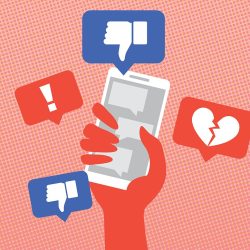Changing Perceptions
A UW study finds that we can lessen prejudice.
Can a simple message reduce prejudice and discrimination?
The work of Markus Brauer, a UW psychology professor who studies human behavior, offers some evidence — and hope — that it can. “The message is that what makes us the same is we are all different,” he says.
Brauer created posters featuring photos of people from a particular racial or ethnic group who have very little resemblance to one another. The individuals vary in age, attractiveness, facial expression, gender, skin color, and formality of clothing, and they are labeled with positive and negative traits, such as joyful and pessimistic.
In one study, participants viewed a version of the poster featuring Arab people before completing a task. They were then sent to another building to receive credit for being part of the experiment, and as they waited in a hallway, a woman of Arab appearance walked by and purposely dropped a plastic bag, spilling its contents.
More than 90 percent of those who saw the poster showing the diversity of Arabs helped the woman in the first twenty seconds of the incident. About 60 percent in the control group, which didn’t see the poster, offered assistance.
Brauer did a follow-up study using two versions of a poster featuring African-American individuals. The results showed that emphasizing both positive and negative character traits was more effective in reducing prejudice than a poster with only positive words.
Companies spend a lot of money on diversity training, but studies show those efforts are “phenomenally ineffective” and don’t result in more women or minorities being hired, Brauer says. Research-based training, which he is developing using the results of his work, can achieve those goals. In a series of twenty laboratory and field experiments, Brauer’s methods effectively reduce prejudice and discrimination.
In another study in France, Brauer and his colleagues created a mock hiring situation. When the most-qualified candidate had an Arabic name — rather than a French name — he was discriminated against. But when the variability of Arabs was emphasized just prior to resumes being reviewed, “the discrimination disappeared,” he says.
Before joining the UW faculty, Brauer spent fifteen years in France, where he also studied reactions to uncivil or immoral behaviors, known as the bystander effect. He and his collaborators employed “confederates,” such as the woman who dropped the bag in the poster study, to, for example, draw graffiti inside an elevator full of people. Researchers then measured their reactions.
Why hire these actors to play a role in research? Brauer says other methods, such as surveys, are not as reliable: “People do not always behave the way they say they behave.”
Published in the Summer 2012 issue



Comments
No comments posted yet.